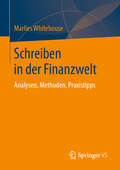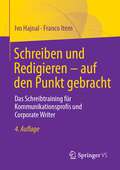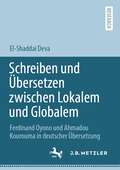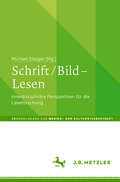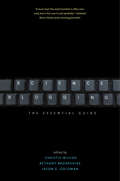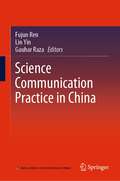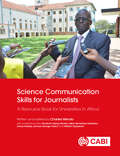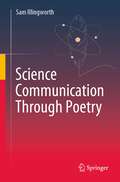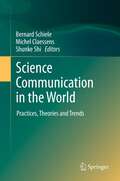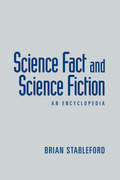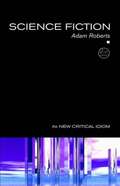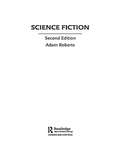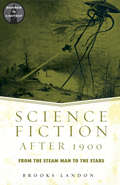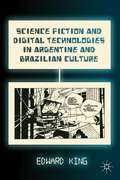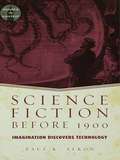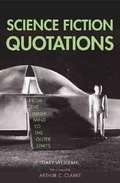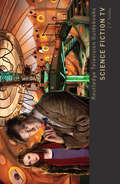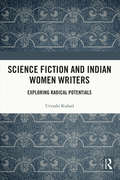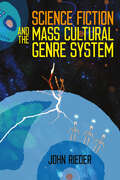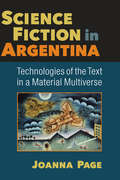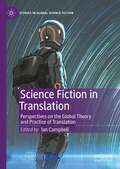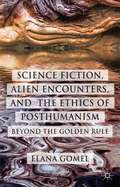- Table View
- List View
Schopenhauer and the Aesthetic Standpoint
by Sophia VasalouWith its pessimistic vision and bleak message of world-denial, it has often been difficult to know how to engage with Schopenhauer s philosophy. His arguments have seemed flawed and his doctrines marred by inconsistencies; his very pessimism almost too flamboyant to be believable. Yet a way of redrawing this engagement stands open, Sophia Vasalou argues, if we attend more closely to the visionary power of Schopenhauer s work. The aim of this book is to place the aesthetic character of Schopenhauer s standpoint at the heart of the way we read his philosophy and the way we answer the question: why read Schopenhauer - and how? Approaching his philosophy as an enactment of the sublime with a longer history in the ancient philosophical tradition, Vasalou provides a fresh way of assessing Schopenhauer s relevance in critical terms. This book will be valuable for students and scholars with an interest in post-Kantian philosophy and ancient ethics.
Schreiben Sie Charaktere Menschen Schaffen, Die Die Leser Lieben Werden: Schreiben Sie Charaktere Menschen Schaffen, Die Die Leser Lieben Werden
by Susan PalmquistSchreiben Sie Charaktere Menschen Schaffen, Die Die Leser Lieben Werden Es ist nicht immer die handlung, die den lesern am meisten an Ihrem buch in erinnerung bleibt, sondern eine oder mehrere Figuren, die ihre aufmerksamkeit fesseln; hält ihr Interesse aufrecht und zwingt sie, weiterzulesen, um herauszufinden, was passiert.
Schreiben in der Finanzwelt: Analysen, Methoden, Praxistipps
by Marlies WhitehouseDas Buch erfasst zuerst den komplexen und dynamischen Kontext, in dem Schreiben in der Finanzwelt geschieht, und untersucht dann am Beispiel einer zentralen Textsorte, was diese Textprodukte tatsächlich leisten. Schließlich entwickelt das Buch forschungsbasierte Werkzeuge, die den Kommunikationserfolg von Finanztexten systematisch und wirksam verbessern können.
Schreiben und Redigieren – auf den Punkt gebracht: Das Schreibtraining für Kommunikationsprofis und Corporate Writer
by Ivo Hajnal Franco ItemDas Buch bietet professionellen Schreiberinnen und Schreibern praxisnahe Anregungen, eigene wie fremde Texte zu optimieren. Ein professioneller Sprachgebrauch hält sich an klare, objektive Vorgaben. Dementsprechend beruht dieses Buch auf empirischen Daten zur Verständlichkeit von Unternehmens- und Medientexten, die in eine leicht umzusetzende Checkliste münden.
Schreiben und Übersetzen zwischen Lokalem und Globalem: Ferdinand Oyono und Ahmadou Kourouma in deutscher Übersetzung
by El-Shaddai DevaÜbersetzer*innen afrikanischer Autoren im deutschen Sprachraum werden oft eurozentrische, kolonialistische und rassistische Absichten unterstellt. Über die Analyse deutscher Übersetzungen ausgewählter Romane von Ferdinand Oyono und Ahmadou Kourouma zeigt El-Shaddai Deva in diesem Buch, dass dies meist zu Unrecht geschieht, da diese Vermittler*innen der afrikanischen Literatur allgemein eine besondere Liebe für den Kontinent, seine Menschen und Kulturen zeigen. Ihre advokatische Haltung geht allerdings mit einer Auffassung der afrikanischen Literatur als Zeitdokument und als Informationsquelle einher. Eine solche Auffassung übt letzten Endes einen Einfluss auf die Ausrichtung der Übersetzung aus: übersetzt wird nicht die Poetik der Originale, sondern ausschließlich deren Inhalt; nicht die lebende Sprache, sondern nur das sprachliche Werkzeug.
Schrift / Bild – Lesen: Interdisziplinäre Perspektiven für die Leseforschung (Abhandlungen zur Medien- und Kulturwissenschaft)
by Michael StaigerIm Zuge der gegenwärtigen Transformation hin zu einer digitalen, multimodal dominierten Medienkultur vollzieht sich ein Wandel des Lesens. Dieser betrifft nicht nur die Lesemedien und die Rezeptionsbedingungen, sondern auch die Medialität und Materialität von Texten. Im Mittelpunkt des Bandes steht die Frage, wie Texte gelesen werden, die Schrift und Bilder miteinander kombinieren. Vorgestellt werden Zugänge aus den Literatur-, Buch- und Medienwissenschaften, aus der Multimodalitätsforschung und Kognitionspsychologie sowie aus Kunstwissenschaft und Deutschdidaktik. Ziel ist es, das Forschungsfeld des Schrift-Bild-Lesens abzustecken und einen Beitrag zu seiner theoretischen Grundlegung zu leisten.
Schumann’s Music and E. T. A. Hoffmann’s Fiction
by John MacauslanFour of Schumann's great masterpieces of the 1830s - Carnaval, Fantasiestücke, Kreisleriana and Nachtstücke - are connected to the fiction of E. T. A. Hoffmann. In this book, John MacAuslan traces Schumann's stylistic shifts during this period to offer insights into the expressive musical patterns that give shape, energy and individuality to each work. MacAuslan also relates the works to Schumann's reception of Bach, Beethoven, Novalis and Jean Paul, and focuses on primary sources in his wide-ranging discussion of the broader intellectual and aesthetic contexts. Uncovering lines of influence from Schumann's reading to his writings, and reflecting on how the aesthetic concepts involved might be used today, this book transforms the way Schumann's music and its literary connections can be understood and will be essential reading for musicologists, performers and listeners with an interest in Schumann, early nineteenth-century music and German Romantic culture.
Science Blogging
by Bethany Brookshire Christie Wilcox Jason G. GoldmanHere is the essential how-to guide for communicating scientific research and discoveries online, ideal for journalists, researchers, and public information officers looking to reach a wide lay audience. Drawing on the cumulative experience of twenty-seven of the greatest minds in scientific communication, this invaluable handbook targets the specific questions and concerns of the scientific community, offering help in a wide range of digital areas, including blogging, creating podcasts, tweeting, and more. With step-by-step guidance and one-stop expertise, this is the book every scientist, science writer, and practitioner needs to approach the Wild West of the Web with knowledge and confidence.
Science Communication Practice in China
by Fujun Ren Lin Yin Gauhar RazaChina has made remarkable and rapid progress in the area of science communication, both in theory and practice. This book critically examines all aspects of science communication practices in China. Dealing with major turning points since the introduction of the ‘Science and Technology Popularization Law’ and the ‘Outline of the National Scheme for Scientific Literacy’, the book tells a success story by scrutinizing structural changes in science communication policies, education system, construction and efficacious utilisation of science popularisation facilities, and creative use of a mix of traditional and modern channels of communication. The book also gives an in-depth analysis of the monitoring and evaluation mechanism, which constitutes the backbone of the national science communication project. The historical roots of science communication in China include shifts in methodologies, policy instruments, effectual approaches and resultant practices since the days of initial efforts to popularise modern scientific ideas. However, the primary focus of the book remains on the initiatives launched at the turn of the present century. Without losing sight of the national dimensions, each chapter of the book draws from provincial as well as grassroots level experiences. Quantitative and qualitative methods have been used to analyse strengths, weaknesses, hurdles and the efficacy of corrective measures. This book offers a remarkable insight to anyone who is interested in probing the causal relationship between science communication and China’s transformation into a modern society. The primary objective of the book is to analyse the nature of ‘science communication with Chinese characteristics’ and the specificity of the socio-cultural environment in which Science and Technology is located. Though the book is of particular interest to scholars, researchers, students and practitioners of science communication, the narrative style makes it accessible to the general reader who is interested in science-society relationship.
Science Communication Skills for Journalists: A Resource Book for Universities in Africa
by Charles WendoThis book has an introduction and 22 other chapters that cover science communication skills. The editor has detailed knowledge of the field and consultation with leading editors and journalists in the region. It provides hands-on guidance together with examples, learning activities, graded and ungraded quizzes to facilitate learning. The content has been tried and tested by lecturers at two universities in Nigeria and Uganda, who used it to successfully train thousands of students in science communication. Each chapter carries hands-on advice on the practice of science journalism, with learning activities to deepen the learner's understanding of the topic. The book also includes five academic systematic review papers, written by university faculty, that that identify, review and synthesize available literature and experiences on science journalism and communication issues in the region. It also includes a case study detailing the experience of Uganda's Makerere University in introducing science journalism and communication into their undergraduate and post-graduate curricula.
Science Communication Through Poetry
by Sam IllingworthScience Communication Through Poetry aims to explore how we might communicate science effectively both to and with non-scientific audiences across the spectrum of science communication, from dissemination to dialogue, via the medium of poetry. It has been written for scientists, science communicators, public engagement practitioners, and poets, so that they can learn how to use poetry as an effective tool through which to diversify science. As well as containing specific advice and guidance for how to use poetry to communicate science with different audiences, this book contains a number of exercises for the reader to reflect on what has been learnt and to put into practice what is discussed. Further study and additional readings are also provided to help improve knowledge, understanding, and familiarity with both poetry and science communication.
Science Communication in the World
by Michel Claessens Shunke Shi Bernard SchieleThis volume is aimed at all those who wonder about the mechanisms and effects of the disclosure of knowledge. Whether they have a professional interest in understanding these processes generally, or they wish to conduct targeted investigations in the PCST field, it will be useful to anyone involved in science communication, including researchers, academics, students, journalists, science museum staff, scientists high public profiles, and information officers in scientific institutions.
Science Fact and Science Fiction: An Encyclopedia
by Brian StablefordScience fiction is a literary genre based on scientific speculation. Works of science fiction use the ideas and the vocabulary of all sciences to create valid narratives that explore the future effects of science on events and human beings. Science Fact and Science Fiction examines in one volume how science has propelled science-fiction and, to a lesser extent, how science fiction has influenced the sciences. Although coverage will discuss the science behind the fiction from the Classical Age to the present, focus is naturally on the 19th century to the present, when the Industrial Revolution and spectacular progress in science and technology triggered an influx of science-fiction works speculating on the future. As scientific developments alter expectations for the future, the literature absorbs, uses, and adapts such contextual visions. The goal of the Encyclopedia is not to present a catalog of sciences and their application in literary fiction, but rather to study the ongoing flow and counterflow of influences, including how fictional representations of science affect how we view its practice and disciplines. Although the main focus is on literature, other forms of science fiction, including film and video games, are explored and, because science is an international matter, works from non-English speaking countries are discussed as needed.
Science Fiction (Second Edition)
by Adam RobertsScience Fiction is a fascinating and comprehensive introduction to one of the most popular areas of modern culture. This second edition reflects how the field is rapidly changing in both its practice and its critical reception
Science Fiction (The New Critical Idiom #Vol. 39672)
by Adam RobertsScience Fiction is a fascinating and comprehensive introduction to one of the most popular areas of modern culture. This second edition reflects how the field is rapidly changing in both its practice and its critical reception. With an entirely new conclusion and all other chapters fully reworked and updated, this volume includes: a concise history of science fiction and the ways in which the genre has been used and defined explanations of key concepts in Science Fiction criticism and theory through chapters such as Gender, Race, Technology and Metaphor examines the interactions between Science Fiction and Science Fact anchors each chapter with a case study drawn from short story, book or film, from Frank Herbert’s Dune to Star Wars, from The Left Hand of Darkness to Neuromancer. Introducing the reader to nineteenth-century, Pulp, Golden Age, New Wave, Feminist and Cyberpunk science fictions, this is the essential contemporary guide to a major cultural movement.
Science Fiction After 1900: From the Steam Man to the Stars (Genres in Context)
by Brooks LandonFirst published in 2003. Routledge is an imprint of Taylor & Francis, an informa company.
Science Fiction And Digital Technologies In Argentine And Brazilian Culture
by Edward KingFictional narratives produced in Latin America often borrow tropes from contemporary science fiction to examine the shifts in the nature of power in neoliberal society. King examines how this leads towards a market-governed control society and also explores new models of agency beyond that of the individual.
Science Fiction Before 1900: Imagination Discovers Technology (Genres in Context #Vol. 3)
by Paul K. AlkonPaul Alkon analyzes several key works that mark the most significant phases in the early evolution of science fiction, including Frankenstein, Twenty Thousand Leagues Under the Sea, A Connecticut Yankee in King arthur's Court and The Time Machine. He places the work in context and discusses the genre and its relation to other kinds of literature.
Science Fiction Quotations: From the Inner Mind to the Outer Limits
by Arthur C. Clarke Gary WestfahlIn this unprecedented collection of science fiction and fantasy quotations, the reader revisits the stunning moment when Mary Shelley's Frankenstein monster first comes to life; witnesses the transformation of Robert Louis Stevenson's Dr. Jekyll into Mr. Hyde; is present when Bruce Wayne resolves to become Batman; and overhears the cosmic conclusions of The Incredible Shrinking Man. Drawing upon two centuries of the vast and provocative literature of science fiction and fantasy, this comprehensive book presents more than 2,900 quotations from wide-ranging sources, including science fiction and fantasy stories, novels, films, and television programs. The quotations are organized by topic-alien worlds; darkness and light; robots, androids, and cyborgs; machines and technology; weapons; and more than one hundred others. The reader will encounter the wit and wisdom of renowned authors (H. G. Wells, Ray Bradbury, J. R. R. Tolkien, Ursula K. Le Guin) along with definitive versions of such important statements as Isaac Asimov's Three Laws of Robotics and Star Trek's Prime Directive. With its thorough index, this book is both an invaluable resource for the writer or scholar and an irresistible page-turner for the curious browser.
Science Fiction TV (Routledge Television Guidebooks)
by J. P. TelotteThe first in the Routledge Television Guidebooks series, Science Fiction TV offers an introduction to the versatile and evolving genre of science fiction television, combining historical overview with textual readings to analyze its development and ever-increasing popularity. J. P. Telotte discusses science fiction’s cultural progressiveness and the breadth of its technological and narrative possibilities, exploring SFTV from its roots in the pulp magazines and radio serials of the 1930s all the way up to the present. From formative series like Captain Video to contemporary, cutting-edge shows like Firefly and long-lived popular revivals such as Doctor Who and Star Trek, Telotte insightfully tracks the history and growth of this crucial genre, along with its dedicated fandom and special venues, such as the Syfy Channel. In addition, each chapter features an in-depth exploration of a range of key historical and contemporary series, including: -Captain Video and His Video Rangers -The Twilight Zone -Battlestar Galactica -Farscape -Fringe Incorporating a comprehensive videography, discussion questions, and a detailed bibliography for additional reading, J. P. Telotte has created a concise yet thought-provoking guide to SFTV, a book that will appeal not only to dedicated science fiction fans but to students of popular culture and media as well.
Science Fiction and Indian Women Writers: Exploring Radical Potentials
by Urvashi KuhadScience fiction, as a literature of fantasy, goes beyond the mundane to ask the question: what if the world were different from the way it is? It often challenges the real, builds on imagination, places no limits on human capacities, and encourages readers to think outside their social and cultural conditioning. This book presents a systematic study of Indian women’s science fiction. It offers a critical analysis of the works of four female Indian writers of science fiction: Rokeya Sakhawat Hossain, Manjula Padmanabhan, Priya Sarukkai Chabria and Vandana Singh. The author considers not only the evolution of science fiction writing in India, but also discusses the use of innovations and unique themes including science fiction in different Indian languages; the literary, political, and educational activism of the women writers; and eco-feminism and the idea of cloning in writing, to argue that this genre could be viewed as a vibrant representation of freedom of expression and radical literature. This ground-breaking volume will be useful for scholars and researchers of English literature. It will also prove a very useful source for further studies into Indian literature, science and technology studies, women’s and gender studies, comparative literature and cultural studies.
Science Fiction and the Mass Cultural Genre System
by John RiederA fresh approach to the history and shape of science fiction In Science Fiction and the Mass Cultural Genre System, John Rieder asks literary scholars to consider what shape literary history takes when based on a historical, rather than formalist, genre theory. Rieder starts from the premise that science fiction and the other genres usually associated with so-called genre fiction comprise a system of genres entirely distinct from the pre-existing classical and academic genre system that includes the epic, tragedy, comedy, satire, romance, the lyric, and so on. He proposes that the field of literary production and the project of literary studies cannot be adequately conceptualized without taking into account the tensions between these two genre systems that arise from their different modes of production, distribution, and reception. Although the careful reading of individual texts forms an important part of this study, the systemic approach offered by Science Fiction and the Mass Cultural Genre System provides a fundamental challenge to literary methodologies that foreground individual innovation.
Science Fiction in Argentina: Technologies of the Text in a Material Multiverse
by Joanna PageIt has become something of a critical commonplace to claim that science fiction does not actually exist in Argentina. This book puts that claim to rest by identifying and analyzing a rich body of work that fits squarely in the genre. Joanna Page explores a range of texts stretching from 1875 to the present day and across a variety of media-literature, cinema, theatre, and comics-and studies the particular inflection many common discourses of science fiction (e.g., abuse of technology by authoritarian regimes, apocalyptic visions of environmental catastrophe) receive in the Argentine context. A central aim is to historicize these texts, showing how they register and rework the contexts of their production, particularly the hallmarks of modernity as a social and cultural force in Argentina. Another aim, held in tension with the first, is to respond to an important critique of historicism that unfolds in these texts. They frequently unpick the chronology of modernity, challenging the linear, universalizing models of development that underpin historicist accounts. They therefore demand a more nuanced set of readings that work to supplement, revise, and enrich the historicist perspective.
Science Fiction in Translation: Perspectives on the Global Theory and Practice of Translation (Studies in Global Science Fiction)
by Ian CampbellScience Fiction in Translation: Perspectives on the Global Theory and Practice of Translation focuses on the process of translation and its implications. The volume explores the translation of works of science fiction (SF) from one language to another and the translation of SF tropes, terms, and ideas of SF theory into cultures outside the West. Providing a comprehensive examination of the state of translation into English, the essays consider how representative the body of translated work of SF is from the source language/culture. It also considers the social, political, and economic choices in selecting a work to translate. The book illustrates the dramatic growth both in SF production outside the Anglosphere, the translation of works from other languages into English, and the practice of translating English-language SF into other languages. Altogether, the essays map the theory, practice, and business of SF translation around the world.
Science Fiction, Alien Encounters, and the Ethics of Posthumanism
by Elana GomelScience Fiction, Alien Encounters, and the Ethics of Posthumanism offers a typology of alien encounters and addresses a range of texts including classic novels of alien encounter by H. G. Wells and Robert Heinlein; recent blockbusters by Greg Bear, Octavia Butler and Sheri Tepper; and experimental science fiction by Peter Watts and Housuke Nojiri.


